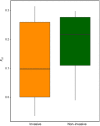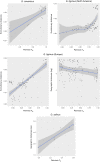Diversity and distribution of genetic variation in gammarids: Comparing patterns between invasive and non-invasive species
- PMID: 29043025
- PMCID: PMC5632605
- DOI: 10.1002/ece3.3208
Diversity and distribution of genetic variation in gammarids: Comparing patterns between invasive and non-invasive species
Abstract
Biological invasions are worldwide phenomena that have reached alarming levels among aquatic species. There are key challenges to understand the factors behind invasion propensity of non-native populations in invasion biology. Interestingly, interpretations cannot be expanded to higher taxonomic levels due to the fact that in the same genus, there are species that are notorious invaders and those that never spread outside their native range. Such variation in invasion propensity offers the possibility to explore, at fine-scale taxonomic level, the existence of specific characteristics that might predict the variability in invasion success. In this work, we explored this possibility from a molecular perspective. The objective was to provide a better understanding of the genetic diversity distribution in the native range of species that exhibit contrasting invasive propensities. For this purpose, we used a total of 784 sequences of the cytochrome c oxidase subunit I of mitochondrial DNA (mtDNA-COI) collected from seven Gammaroidea, a superfamily of Amphipoda that includes species that are both successful invaders (Gammarus tigrinus, Pontogammarus maeoticus, and Obesogammarus crassus) and strictly restricted to their native regions (Gammarus locusta, Gammarus salinus, Gammarus zaddachi, and Gammarus oceanicus). Despite that genetic diversity did not differ between invasive and non-invasive species, we observed that populations of non-invasive species showed a higher degree of genetic differentiation. Furthermore, we found that both geographic and evolutionary distances might explain genetic differentiation in both non-native and native ranges. This suggests that the lack of population genetic structure may facilitate the distribution of mutations that despite arising in the native range may be beneficial in invasive ranges. The fact that evolutionary distances explained genetic differentiation more often than geographic distances points toward that deep lineage divergence holds an important role in the distribution of neutral genetic diversity.
Keywords: Gammaridae; aquatic invasive species; biological invasions; genetic diversity; population differentiation.
Figures


Similar articles
-
Disentangling the determinants of symbiotic species richness in native and invasive gammarids (Crustacea, Amphipoda) of the Baltic region.Int J Parasitol. 2023 May;53(5-6):305-316. doi: 10.1016/j.ijpara.2023.02.006. Epub 2023 Mar 31. Int J Parasitol. 2023. PMID: 37004736
-
Database on eukaryotic symbionts of native and invasive gammarids (Crustacea, Amphipoda) in the Baltic region of Poland with information on water parameters for sampling sites.Data Brief. 2023 Jun 9;49:109308. doi: 10.1016/j.dib.2023.109308. eCollection 2023 Aug. Data Brief. 2023. PMID: 37360672 Free PMC article.
-
Do alternative resources dampen functional responses of native but not alien gammarids?Ecol Evol. 2022 Sep 9;12(9):10.1002/ece3.9262. doi: 10.1002/ece3.9262. eCollection 2022 Sep. Ecol Evol. 2022. PMID: 36177140 Free PMC article.
-
Temperature, not salinity, drives impact of an emerging invasive species.Sci Total Environ. 2021 Aug 1;780:146640. doi: 10.1016/j.scitotenv.2021.146640. Epub 2021 Mar 21. Sci Total Environ. 2021. PMID: 33774308
-
Gridlock and beltways: the genetic context of urban invasions.Oecologia. 2020 Mar;192(3):615-628. doi: 10.1007/s00442-020-04614-y. Epub 2020 Feb 13. Oecologia. 2020. PMID: 32056021 Review.
Cited by
-
An environmental gradient dominates ecological and genetic differentiation of marine invertebrates between the North and Baltic Sea.Ecol Evol. 2022 May 20;12(5):e8868. doi: 10.1002/ece3.8868. eCollection 2022 May. Ecol Evol. 2022. PMID: 35600684 Free PMC article.
-
First true brackish-water nudibranch mollusc provides new insights for phylogeny and biogeography and reveals paedomorphosis-driven evolution.PLoS One. 2018 Mar 14;13(3):e0192177. doi: 10.1371/journal.pone.0192177. eCollection 2018. PLoS One. 2018. PMID: 29538398 Free PMC article.
-
Metabolic rate and climate change across latitudes: evidence of mass-dependent responses in aquatic amphipods.J Exp Biol. 2022 Nov 15;225(22):jeb244842. doi: 10.1242/jeb.244842. Epub 2022 Nov 25. J Exp Biol. 2022. PMID: 36337048 Free PMC article.
References
-
- Audzijonyte, A. , Wittmann, K. J. , Ovcarenko, I. , & Väinölä, R. (2009). Invasion phylogeography of the Ponto‐Caspian crustacean Limnomysis benedeni dispersing across Europe. Diversity and Distributions, 15, 346–355.
-
- Bij de Vaate, A. , Jazdzewski, K. , Ketelaars, H. A. , Gollasch, S. , & Van der Velde, G. (2002). Geographical patterns in range extension of Ponto‐Caspian macroinvertebrate species in Europe. Canadian Journal of Fisheries and Aquatic Sciences, 59, 1159–1174.
-
- Bock, D. G. , Caseys, C. , Cousens, R. D. , Hahn, M. A. , Heredia, S. M. , Hübner, S. , … Rieseberg, L. H. (2015). What we still don't know about invasion genetics. Molecular Ecology, 24, 2277–2297. - PubMed
-
- Briski, E. , Allinger, L. E. , Balcer, M. , Cangelosi, A. , Fanberg, L. , Markee, T. P. , … Reavie, E. D. (2013). Multidimensional approach to invasive species prevention. Environmental Science & Technology, 47, 1216–1221. - PubMed
-
- Briski, E. , Chan, F. T. , MacIsaac, H. J. , & Bailey, S. A. (2014). A conceptual model of community dynamics during the transport stage of the invasion process: A case study of ships’ ballast. Diversity and Distributions, 20, 236–244.
LinkOut - more resources
Full Text Sources
Other Literature Sources

